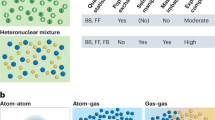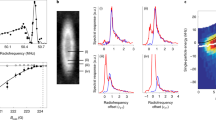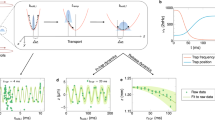Abstract
Ultracold quantum gases play a pivotal role in many-body physics, quantum sensing and quantum simulation. Over time, methods such as evaporative cooling in bulk ensembles and precision laser-cooling have been employed to effectively achieve quantum degeneracy in atomic gases. A simpler and more rapid way to form quantum gases would, thus, hold considerable promise in advancing the field. Here, we report the creation of a quantum gas by cooling individual rubidium atoms pinned in a three-dimensional optical lattice using electromagnetically induced transparency and adiabatic expansion. After just 10 ms of cooling, we verified the phase transition from a thermal to a quantum gas by adiabatically transferring the atoms to optical dipole traps. We observed the collapse of atoms in three-dimensional traps, a distinctive hallmark of a quantum gas with negative scattering length. Additionally, in a one-dimensional optical trap, we observed the emergence of a stable and strongly correlated quantum gas. Our results introduce a versatile and fast approach to achieving quantum degenerate gases with minimal time and resource requirements.
This is a preview of subscription content, access via your institution
Access options
Access Nature and 54 other Nature Portfolio journals
Get Nature+, our best-value online-access subscription
27,99 € / 30 days
cancel any time
Subscribe to this journal
Receive 12 print issues and online access
269,00 € per year
only 22,42 € per issue
Buy this article
- Purchase on SpringerLink
- Instant access to full article PDF
Prices may be subject to local taxes which are calculated during checkout




Similar content being viewed by others
Data availability
Source data are provided with this paper. All other data that support the plots within this paper and other findings of this study are available from the corresponding authors upon reasonable request.
Code availability
The computer code used to support the conclusions of the current study is available from the corresponding author on reasonable request.
References
Anderson, M. H., Ensher, J. R., Matthews, M. R., Wieman, C. E. & Cornell, E. A. Observation of Bose-Einstein condensation in a dilute atomic vapor. Science 269, 198–201 (1995).
Pethick, C. J. & Smith, H. Bose-Einstein Condensation in Dilute Gases 2nd edn (Cambridge Univ. Press, 2008).
Davis, K. B., Mewes, M.-O., Joffe, M. A., Andrews, M. R. & Ketterle, W. Evaporative cooling of sodium atoms. Phys. Rev. Lett. 74, 5202 (1995).
Stellmer, S., Pasquiou, B., Grimm, R. & Schreck, F. Laser cooling to quantum degeneracy. Phys. Rev. Lett. 110, 263003 (2013).
Hu, J. et al. Creation of a Bose-condensed gas of 87Rb by laser cooling. Science 358, 1078–1080 (2017).
Urvoy, A., Vendeiro, Z., Ramette, J., Adiyatullin, A. & Vuletić, V. Direct laser cooling to Bose-Einstein condensation in a dipole trap. Phys. Rev. Lett. 122, 203202 (2019).
Solano, P. et al. Strongly correlated quantum gas prepared by direct laser cooling. Phys. Rev. Lett. 123, 173401 (2019).
Vuletić, V., Chin, C., Kerman, A. J. & Chu, S. Degenerate Raman sideband cooling of trapped cesium atoms at very high atomic densities. Phys. Rev. Lett. 81, 5768–5771 (1998).
DePue, M. T., McCormick, C., Winoto, S. L., Oliver, S. & Weiss, D. S. Unity occupation of sites in a 3D optical lattice. Phys. Rev. Lett. 82, 2262–2265 (1999).
Kerman, A. J., Vuletić, V., Chin, C. & Chu, S. Beyond optical molasses: 3D Raman sideband cooling of atomic cesium to high phase-space density. Phys. Rev. Lett. 84, 439–442 (2000).
Han, D.-J. et al. 3D Raman sideband cooling of cesium atoms at high density. Phys. Rev. Lett. 85, 724–727 (2000).
Olshanii, M. & Weiss, D. Producing Bose-Einstein condensates using optical lattices. Phys. Rev. Lett. 89, 090404 (2002).
Morigi, G., Eschner, J. & Keitel, C. H. Ground state laser cooling using electromagnetically induced transparency. Phys. Rev. Lett. 85, 4458 (2000).
Morigi, G. Cooling atomic motion with quantum interference. Phys. Rev. A 67, 033402 (2003).
He, P., Tengdin, P. M., Anderson, D. Z., Rey, A. M. & Holland, M. Sub-Doppler laser cooling using electromagnetically induced transparency. Phys. Rev. A 95, 053403 (2017).
Huang, C., Chai, S. & Lan, S.-Y. Dark-state sideband cooling in an atomic ensemble. Phys. Rev. A 103, 013305 (2021).
Ketterle, W., Davis, K. B., Joffe, M. A., Martin, A. & Pritchard, D. E. High densities of cold atoms in a dark spontaneous-force optical trap. Phys. Rev. Lett. 70, 2253 (1993).
Leong, W. S. et al. Large array of Schrödinger cat states facilitated by an optical waveguide. Nat. Commun. 11, 5295 (2020).
Kastberg, A., Phillips, W. D., Rolston, S. L., Spreeuw, R. J. C. & Jessen, P. S. Adiabatic cooling of cesium to 700 nK in an optical lattice. Phys. Rev. Lett. 74, 1542 (1995).
Ruprecht, P., Holland, M. J., Burnett, K. & Edwards, M. Time-dependent solution of the nonlinear Schrödinger equation for Bose-condensed trapped neutral atoms. Phys. Rev. A 51, 4704 (1995).
Donley, E. A. et al. Dynamics of collapsing and exploding Bose‐Einstein condensates. Nature 412, 295 (2001).
Rychtarik, D., Engeser, B., Nägerl, H.-C. & Grimm, R. Two-dimensional Bose-Einstein condensate in an optical surface trap. Phys. Rev. Lett. 92, 173003 (2004).
Saito, H. & Ueda, M. Mean-field analysis of collapsing and exploding Bose-Einstein condensates. Phys. Rev. A 65, 033624 (2002).
Cornish, S. L., Thompson, S. T. & Wieman, C. E. Formation of bright matter-wave solitons during the collapse of attractive Bose-Einstein condensates. Phys. Rev. Lett. 96, 170401 (2006).
Altin, P. A. et al. Collapse and three-body loss in a 85Rb Bose-Einstein condensate. Phys. Rev. A 84, 033632 (2011).
Santos, L. & Shlyapnikov, G. V. Collapse dynamics of trapped Bose-Einstein condensates. Phys. Rev. A 66, 011602(R) (2002).
Parker, N. G., Cornish, S. L., Adams, C. S. & Martin, A. M. Bright solitary waves and trapped solutions in Bose–Einstein condensates with attractive interactions. J. Phys. B: At. Mol. Phys. 40, 3127 (2007).
McDonald, G. D. et al. Bright solitonic matter-wave interferometer. Phys. Rev. Lett. 113, 013002 (2014).
Astrakharchik, G. E., Blume, D., Giorgini, S. & Granger, B. E. Quasi-one-dimensional Bose gases with a large scattering length. Phys. Rev. Lett. 92, 030402 (2004).
Haller, E. et al. Realization of an excited, strongly correlated quantum gas phase. Science 325, 1224 (2009).
Petrov, D. S., Shlyapnikov, G. V. & Walraven, J. T. M. Regimes of quantum degeneracy in trapped 1D gases. Phys. Rev. Lett. 85, 3745–3749 (2000).
Kinoshita, T., Wenger, T. & Weiss, D. S. Local pair correlations in one-dimensional Bose gases. Phys. Rev. Lett. 95, 190406 (2005).
Kormos, M., Mussardo, G. & Trombettoni, A. Local correlations in the super-Tonks–Girardeau gas. Phys. Rev. A 83, 013617 (2011).
Bongs, K. et al. Taking atom interferometric quantum sensors from the laboratory to real-world applications. Nat. Rev. Phys. 1, 731–739 (2019).
Tino, G. M. Testing gravity with cold atom interferometry: results and prospects. Quantum Sci. Technol. 6, 024014 (2021).
Bloch, I., Dalibard, J. & Zwerger, W. Many-body physics with ultracold gases. Rev. Mod. Phys. 80, 885 (2008).
Bloch, I., Dalibard, J. & Nascimbène, S. Quantum simulations with ultracold quantum gases. Nat. Phys. 8, 267–276 (2012).
Schreck, F. & Druten, K. Laser cooling for quantum gases. Nat. Phys. 17, 1296–1304 (2021).
Dunjko, V., Lorent, V. & Olshanii, M. Bosons in cigar-shaped traps: Thomas-Fermi regime, Tonks-Girardeau regime, and in between. Phys. Rev. Lett. 86, 5413–5416 (2001).
Kheruntsyan, K. V., Gangardt, D. M., Drummond, P. D. & Shlyapnikov, G. V. Finite-temperature correlations and density profiles of an inhomogeneous interacting one-dimensional Bose gas. Phys. Rev. A 71, 053615 (2005).
Steck, D. A. Rubidium 85 D line data, revision 2.3.2. steck.us https://steck.us/alkalidata/ (2023).
Acknowledgements
We gratefully acknowledge stimulating discussions with M.-S. Chang and S.-W. Chiow. This work was supported by the Singapore National Research Foundation (Grant Nos. QEP-P4 and NRF2021-QEP2-03-P01 to S.L.), the Singapore Ministry of Education (Grant No. MOE-T2EP50121-0021 to S.L.), the Yushan Fellow Programme of the Ministry of Education of Taiwan (S.L.) and the 2030 Cross-Generation Young Scholars Programme of the National Science and Technology Council of Taiwan (Grant No. 112-2628-M-002-013- to S.L.).
Author information
Authors and Affiliations
Contributions
M.X., W.S.L. and S.-Y.L. conceived and designed the experiment and analysed the data. M.X. and W.S.L. built the experimental set-up and performed the measurements. S.-Y.L. wrote the manuscript with input and revisions from all authors. S.-Y.L. supervised the project and advised on the overall results in the manuscript. M.X., W.S.L., Z.C., Y.W. and S.-Y.L. discussed the results.
Corresponding authors
Ethics declarations
Competing interests
The authors declare no competing interests.
Peer review
Peer review information
Nature Physics thanks the anonymous reviewers for their contribution to the peer review of this work.
Additional information
Publisher’s note Springer Nature remains neutral with regard to jurisdictional claims in published maps and institutional affiliations.
Extended data
Extended Data Fig. 1 Configuration of the optical alignments for EIT cooling, optical lattices, and optical dipole trap.
All the beams follow the x-y plane and y-z planes. The EIT cooling beams follow the MOT beams alignment indicated by the red arrows with circular polarizations. The green arrows that follow the x, y, and z coordinates represent the optical lattices. The blue arrows are the optical dipole trap lasers.
Extended Data Fig. 2 Time-of-flight absorption images after the collapse of the quantum gas.
The x trap is switched on during the last EIT cooling and turned off after 0.9 ms of the adiabatic cooling for the TOF imaging. Gravity acts in the downward z direction.
Extended Data Fig. 3 Fluorescence images at different sequence stages with a large initial filling factor.
The measured filling factors for the images from left to right are 0.73(1), 2.83(2), and 2.23(1), respectively. The colour scale is in arbitrary unit.
Extended Data Fig. 4 Last EIT cooling performance for Extended Data Fig. 3.
Atom number and filling factor versus the last EIT cooling time when the initial filling factor is more than 2 before the last EIT cooling. The atom number is measured by fluorescence imaging, and the cloud size is measured by absorption imaging. The 7% atom number decay in 300 μs is mainly the light scattering loss of atoms that are not trapped by the optical lattice. The error bars denote the standard error of the mean of four measurements and include only statistical errors.
Extended Data Fig. 5 Vibrational spectroscopy with a filling factor of 2.5.
The spectroscopy is performed after the last EIT cooling along the x axis. The error bars denote the standard error of the mean of four measurements.
Extended Data Fig. 6 Comparison of the ideal and 1D quantum gas using Gaussian fit.
a, The density profile is projected along the y axis after adiabatically turning off the y lattice with ta = 0.2 ms (ideal gas) and ta = 1 ms (1D quantum gas). The data are taken after holding the atoms in the tubes for 10 μs and releasing them with 3 ms TOF. The data curves are fitted with a Gaussian function and the shaded areas represents the difference between the data and the fitted Gaussian functions. b, A 10 ms TOF image of the 1D gas after released from the lattice using the coldest atoms depicted in Fig. 4a for comparison. The errror bars denote the standard error of the mean of 30 measurements.
Extended Data Fig. 7 Absorption imaging.
a, Absorption image of the atomic cloud in the 3D lattice after the last EIT cooling with most atoms in the F = 3 state for ODp measurement. The absorption beam is red-detuned by 23.4 MHz from the atomic resonance. b, Absorption image of the atomic cloud in the 3D lattice after the last EIT cooling with most atoms in the F = 2 state for cloud size measurement. The absorption beam is tuned to atomic resonance. The colour bar represents measured optical depth.
Supplementary information
Supplementary Video 1
The collapse dynamics in the y trap at ta = 1 ms. In situ absorption imaging after loading and holding atoms in the y trap. Same collapse process as in Fig. 3a.
Supplementary Video 2
The collapse in the x trap at different ta. Absorption images of the collapse after 10 μs in the x trap and 2 ms TOF. Same collapse process as in Fig. 3d.
Supplementary Video 3
The collapse dynamics in the x trap at ta = 0.9 ms. Same collapse process as in Extended Data Fig. 2.
Source data
Source Data Fig. 2
Source data for the plots.
Source Data Fig. 3
Source data for the plots.
Source Data Fig. 4
Source data for the plots.
Source Data Extended Data Fig.2
Source data for the plots.
Source Data Extended Data Fig.3
Source data for the plots.
Source Data Extended Data Fig.4
Source data for the plots.
Source Data Extended Data Fig.5
Source data for the plots.
Source Data Extended Data Fig.6
Source data for the plots.
Source Data Extended Data Fig.7
Source data for the plots.
Rights and permissions
Springer Nature or its licensor (e.g. a society or other partner) holds exclusive rights to this article under a publishing agreement with the author(s) or other rightsholder(s); author self-archiving of the accepted manuscript version of this article is solely governed by the terms of such publishing agreement and applicable law.
About this article
Cite this article
Xin, M., Leong, W.S., Chen, Z. et al. Fast quantum gas formation via electromagnetically induced transparency cooling. Nat. Phys. 21, 63–69 (2025). https://doi.org/10.1038/s41567-024-02677-9
Received:
Accepted:
Published:
Issue Date:
DOI: https://doi.org/10.1038/s41567-024-02677-9



